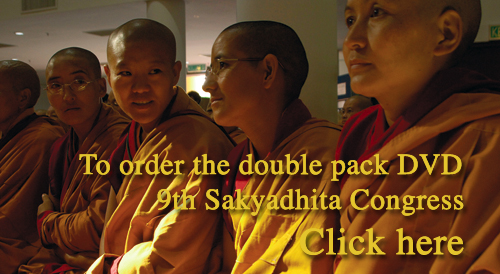“BUDDHISM IN TRANSITION : TRADITIONS, CHANGES, AND CHALLENGES”
Ulaanbaatar, Mongolia
Conference: July 1 to 5, 2008
Temple Tours: July 6 and 7, 2008
MONGOLIA : LAND OF THE ETERNAL BLUE SKY
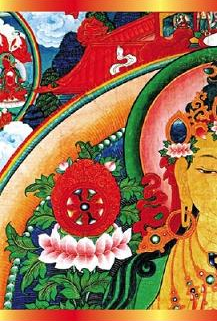 Mongolia, located between Russia and China, has three major mountain ranges and rivers running in three directions. The altitude varies between 560 and 1,374 m (1,837 and 4,508 ft). Temperatures range widely from -40 to + 38 C (-40 to 100 F). The fragile ecosystem encompasses arid deserts and range lands, with half the country covered in permafrost. The vast desert expanses and gentle rolling hills of Mongolia are home to millions of sleepy-looking Bactrian camels, fluffy sheep, impressive yaks, and spirited horses. A sparse human population of 2.7 million shares this landscape, 36 percent under 14 years old. Sixty percent of the people are nomads who live in round tents called ger, with the others settled in towns or the capital city of Ulaanbaatar.
Mongolia, located between Russia and China, has three major mountain ranges and rivers running in three directions. The altitude varies between 560 and 1,374 m (1,837 and 4,508 ft). Temperatures range widely from -40 to + 38 C (-40 to 100 F). The fragile ecosystem encompasses arid deserts and range lands, with half the country covered in permafrost. The vast desert expanses and gentle rolling hills of Mongolia are home to millions of sleepy-looking Bactrian camels, fluffy sheep, impressive yaks, and spirited horses. A sparse human population of 2.7 million shares this landscape, 36 percent under 14 years old. Sixty percent of the people are nomads who live in round tents called ger, with the others settled in towns or the capital city of Ulaanbaatar.
Ulaanbaatar is situated in a northern valley area at 1,350 m (4,430 ft) above sea level. The summer climate in July is pleasant, with an average temperature of 16 C (62 F) and occasional rain. The roads, mostly unpaved, transport travelers by bus, minivan, and taxi. Favorite local foods include mutton and dumplings; vegetarian dishes and the cuisines of many countries are also available. Gorkhi-Terelj National Park, about 80 km (50 mi) outside the capital,
boasts of some of the loveliest scenery in the country. For shopping, Mongolian cashmere is world famous.
BUDDHISM IN MONGOLIA
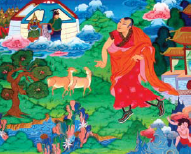 Mongolia was made famous by Chingghis Khan, the fearsome 13th-century warrior who conquered vast territories, but was also known for his tolerance toward Christians, Muslims, Manicheists, and shamans living in his realm. His grandson established a lama-patron relationship with the Tibetan scholar Sakya Pandita, whose nephew Chogyal Phagpa spread Buddhism at the Mongolian court, including to Khubilai Khan. When Altan Khan came to power in the 16th century, he met the Tibetan Buddhist teacher Sonam Gyatso and gave him the title Dalai Lama, meaning “ocean of wisdom.” Their meeting touched off a revival of Buddhism, which flourished as the dominant religious tradition with a strong monastic order that continued up to the 1930s.
Mongolia was made famous by Chingghis Khan, the fearsome 13th-century warrior who conquered vast territories, but was also known for his tolerance toward Christians, Muslims, Manicheists, and shamans living in his realm. His grandson established a lama-patron relationship with the Tibetan scholar Sakya Pandita, whose nephew Chogyal Phagpa spread Buddhism at the Mongolian court, including to Khubilai Khan. When Altan Khan came to power in the 16th century, he met the Tibetan Buddhist teacher Sonam Gyatso and gave him the title Dalai Lama, meaning “ocean of wisdom.” Their meeting touched off a revival of Buddhism, which flourished as the dominant religious tradition with a strong monastic order that continued up to the 1930s.
At the beginning of the 20th century, there were 583 monasteries and temple complexes and 243 incarnate lamas in the Mongolian territories, including 157 in what today is called Inner Mongolia. By 1920, there were said to be 110,000 monks (about 1/3 of the male population), who controlled much of the country’s wealth. In the 1930s, under Stalin, more than 30,000 Mongolians, mostly monks, were arrested and disappeared. All the monasteries but one were closed and religious worship and ceremonies were outlawed. Not until 1990 was freedom of religion restored. Since then, there has been a phenomenal revival of Buddhism (and other religions) in the country. Monasteries have reopened and Mongolians are reviving their Buddhist traditions.
SAKYADHITA : DAUGHTERS OF THE BUDDHA
Since 1987, Sakyadhita has worked to benefit women and enhance their capacity to work for peace, justice, and the welfare of all living beings. We hope you will join us at the 10th Sakyadhita International Conference on Buddhist Women to learn more about Mongolia and link up with a vibrant community of Buddhist women dedicated to global
transformation.
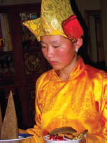 In July 2008, Buddhist women and friends from around the world will meet in Ulaanbaatar, capital of Mongolia, to exchange ideas and learn from one another. As traditional cultures confront new global realities – social, political, and economic – ancient beliefs and practices are being adapted to meet the needs of contemporary life. Buddhists throughout the world are aware of the tremendous changes occurring in their societies and the many challenges they face in maintaining their traditional values in today’s fast-paced, often troubled world. How can Buddhist ideals – loving kindness, compassion, generosity, and wisdom – be useful in meeting these challenges? What roles can women play to help their families and communities maintain and nurture their Buddhist values?
In July 2008, Buddhist women and friends from around the world will meet in Ulaanbaatar, capital of Mongolia, to exchange ideas and learn from one another. As traditional cultures confront new global realities – social, political, and economic – ancient beliefs and practices are being adapted to meet the needs of contemporary life. Buddhists throughout the world are aware of the tremendous changes occurring in their societies and the many challenges they face in maintaining their traditional values in today’s fast-paced, often troubled world. How can Buddhist ideals – loving kindness, compassion, generosity, and wisdom – be useful in meeting these challenges? What roles can women play to help their families and communities maintain and nurture their Buddhist values?
BACKGROUND OF THE CONFERENCE
Since 1987, Buddhist women have been meeting internationally
every two years. Representing over three hundred million Buddhist women worldwide, we have forged friendships and created a global alliance to work toward a more sane and peaceful world. These fruitful and affirming exchanges have had lasting intellectual, spiritual, and personal significance for thousands of women.
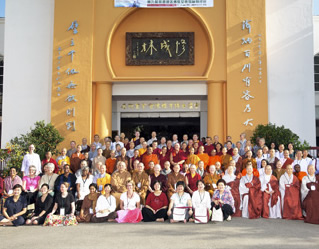
Attendees of the 9th Sakyadhita conference in Kuala Lumpur, Malaysia
Gatherings in India, Thailand, Sri Lanka, Ladakh, Cambodia, Nepal, Taiwan, Korea, Malaysia, and the U.S. have stimulated a global movement among Buddhist women around the world, working for inner peace, communal harmony, and global justice. Proceedings from these conferences have been compiled in a series of books, videos, and newsletters that document the achievements of Buddhist women’s 2,500-year history.
BRINGING WOMEN TOGETHER
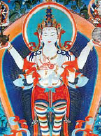 In tune with Sakyadhita’s mission of global cooperation, the 10th Sakyadhita International Conference on Buddhist
In tune with Sakyadhita’s mission of global cooperation, the 10th Sakyadhita International Conference on Buddhist
Women is being organized by representatives of a variety of Buddhist organizations in Mongolia working in partnership with members of Sakyadhita’s International Conference Planning Committee. Sakyadhita is the world’s most active international association of Buddhist women, a global alliance dedicated to nurturing women’s potential for compassionate social engagement. The aim is to create opportunities for the exchange of learning, training, and experience with Buddhists and friends from diverse cultures, religions, and social backgrounds.
CONFERENCE PROGRAM
Leading Buddhist scholars, practitioners, artists, and social
activists from around the world will offer ideas and
insights on critical issues facing contemporary society.
Morning meditations and evening chanting will provide
glimpses of the world’s rich Buddhist traditions. Small
group discussions, interdisciplinary panels, and workshops
will facilitate dialogue among participants. The
overall conference theme is “Buddhism in Transition:
Tradition, Changes, and Challenges.”
PROPOSED PANEL THEMES
• Buddhist Women in Times of Transition
• The Challenges of Multiculturalism
• Breaking with Tradition: The Issue of Legitimacy
• Buddhism and Consumerism
• The Future of Monasticism
• Buddhist Women and Interreligious Dialogue
• Engaging the Younger Generation
• Buddhism and Cultural Change: Issues of Family
• Buddhist Values and Environmental Health
• Buddhism, Politics, and Human Rights
PROPOSED WORKSHOP THEMES
• Buddhist Meditation Traditions
• Working Together: Alternatives to Hierarchy, New Models of Organization
• What’s the Problem? (Problem-solving Skills)
• Buddhism, Women, and Health
• Nonprofit Management Skills for Branches, Chapters, and Grant Recipients
• Lifestyle Choices
• Buddhism in the Workplace
• Notes in a Nutshell and Other Skills for Sakyadhita
Writers
CONFERENCE SCHEDULE
June 30 Arrival in Ulaanbaatar
July 1 Opening Ceremony at the Mongolia Cultural
Palace
July 2-4 Conference Sessions: Meditation, talks,
discussions, and workshops
July 5 Closing Ceremony at the Mongolia Cultural
Palace
July 6 Temple Tour in Ulaanbaatar
July 7 Excursion to Manjusri Monastery
Source : www.sakyadhita.org


